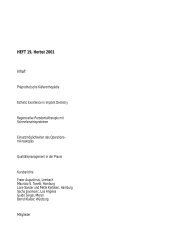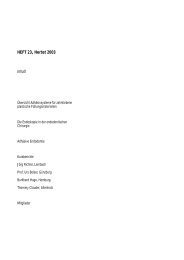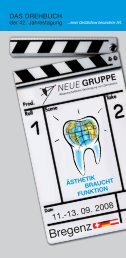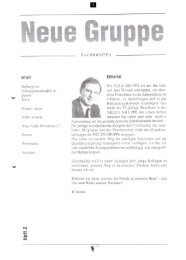KONTROVERSEN IN DER PARODONTOLOGIE - Neue Gruppe
KONTROVERSEN IN DER PARODONTOLOGIE - Neue Gruppe
KONTROVERSEN IN DER PARODONTOLOGIE - Neue Gruppe
Erfolgreiche ePaper selbst erstellen
Machen Sie aus Ihren PDF Publikationen ein blätterbares Flipbook mit unserer einzigartigen Google optimierten e-Paper Software.
<strong>KONTROVERSEN</strong> <strong>IN</strong> <strong>DER</strong><br />
<strong>PARODONTOLOGIE</strong><br />
Konsequenzen für die Praxis<br />
One-stage, Full-mouth Disinfection<br />
Freitag, 18. 11. 2005 • 11.15 – 13.00 Uhr<br />
DH/ZMF-Seminar – Saal 6<br />
Prof. Dr. Marc Quirynen (CV siehe S. 24)<br />
The existence of an "intra-oral” transmission of bacteria (from one niche to another, also called<br />
translocation or cross-infection) has recently been thoroughly investigated. In order to reduce<br />
the chance for an intra-oral transmission (also called cross-contamination), the "one-stage, fullmouth<br />
disinfection" has been introduced. This strategy attempts to eradicate, or at least suppress,<br />
periodontopathogens in a short time span, and this not only from the periodontal pockets but<br />
from all their intra-oral habitats (mucous membranes, tongue, and saliva). The one-stage fullmouth<br />
disinfection concept consists of a combination of following therapeutic efforts: a full<br />
mouth scaling and root planing within 24 to reduce the number of subgingival pathogenic<br />
organisms, a subgingival irrigation of all pockets with a 1% chlorhexidine gel in order to kill<br />
remaining bacteria, tongue brushing with an antiseptic to suppress the bacteria in this niche,<br />
mouth rinsing with an antiseptic to reduce the bacteria in the saliva and on the tonsils. Several<br />
comparative studies between the one-stage, full-mouth approach and the standard therapy<br />
(root planing per quadrant with 2 week intervals), clearly illustrated the benefits of such a fullmouth<br />
approach in relation to gain in attachment, pocket depth reduction, microbiological shifts<br />
(for review see Quirynen et al. (2001)). A similar approach also resulted in significant additional<br />
improvements during guided tissue regeneration and/or the application of local antibiotics.<br />
My presentations will give a general overview on the scientific background of the intra-oral<br />
bacterial transmission, as well as of most recent clinical observations with the full-mouth<br />
strategies, including additional improvements of the concept.<br />
Chemotherapeutic Control of Malodour<br />
Breath malodour is a considerable social problem, the incidence of which remains poorly<br />
documented in most countries. Several studies in industrialized countries reported incidences<br />
up to 50%, with a variety degree of intensity. From large scale inventories in multidisciplinary<br />
breath odour outpatient clinics it appears that in the vast majority (85 %) the cause originates<br />
from the oral cavity. Gingivitis, periodontitis and tongue coating are the predominant factors.<br />
Since more than 90% of the population suffers from gingivitis and/or periodontitis, there<br />
is however the risk that such plaque-related inflammatory condition is too easily considered<br />
the cause, while in fact more important pathologies are being overlooked. Indeed, for a minority<br />
of patients extra-oral causes can be identified including: ENT pathology, systemic diseases<br />
(e.g. diabetes, metabolic or hormonal problems, hepatic or renal insufficiency, a bronchial carcinoma<br />
or a gastro-enterologic pathology). A category of subjects imagine they have breath<br />
malodour. This is called imaginary breath odour or halitophobia.<br />
The unpleasant smell of breath mainly originates from volatile sulphide compounds (VSCs).<br />
However, other compounds in mouth air may also be offensive, such as: diamines (e.g. putrescine<br />
and cadaverine), indole, skatole, and butyric or propionic acid. Most of these compounds<br />
result from the proteolytic degradation by oral microorganisms of peptides (sulphide<br />
or non-sulphide containing amino acids) present in saliva, shed epithelium, food debris, gingival<br />
crevicular fluid, interdental plaque, postnasal drip, and blood. Especially gram-negative,<br />
anaerobic bacteria possess such proteolytic activity. When hormonal, gastro-intestinal, renal or<br />
metabolic pathologies are the cause, additional malodorous molecules can be produced<br />
which circulate in the blood and are expressed through the expired air or the crevicular fluid.<br />
Strong antiseptics (e.g. mouth rinses) can reduce oral malodour by killing the bacteria, but of<br />
course have no impact on a bad breath from a non-oral origin. The removal of the substrata<br />
for bacteria (e.g. tongue coating) forms another important treatment strategy, and should not<br />
be forgotten.<br />
Dieser Vortrag wird von der Firma GlaxoSmithKline Consumer Healthcare unterstützt.<br />
27










